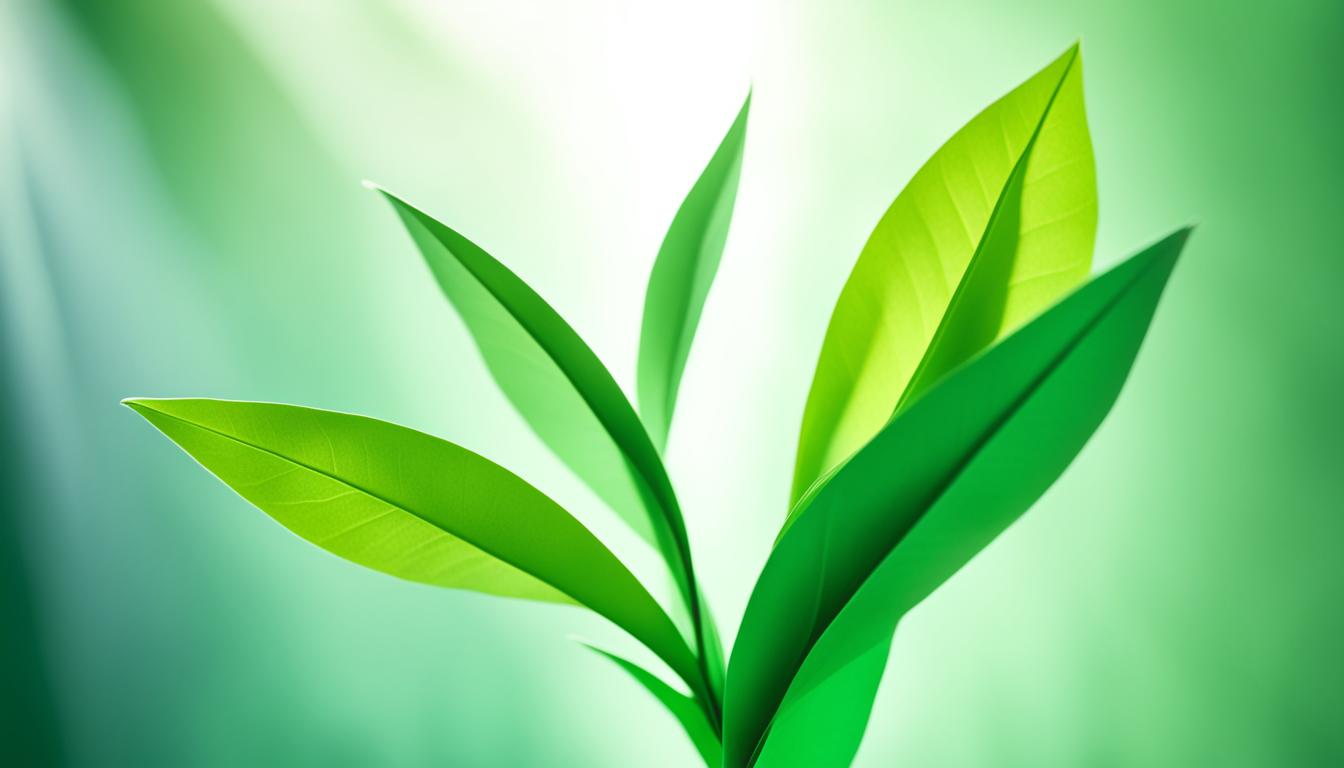Did you know having plants in your place makes it prettier and boosts your mood? Indoor plants help reduce stress, make you more productive, and clean the air. The Paper Plant is a great option for anyone. This guide will cover everything about the Paper Plant. From its benefits to how to take care of it. It’s perfect for new or experienced plant lovers. This guide will make growing a Paper Plant easy.
Key Takeaways:
- Discover the numerous benefits of having a Paper Plant in your apartment.
- Learn about the air-purifying and pet-friendly qualities of the Paper Plant.
- Understand the growth requirements and how to care for a Paper Plant in your apartment.
- Explore the unique appearance of the Paper Plant and its stunning foliage.
- Find out how to properly water, fertilize, and pot a Paper Plant for optimal growth.
Why Do We Love the Paper Plant For Apartments?
The Paper Plant is great for apartments. It cleans the air and is safe for pets. It also fits well in small spaces because it doesn’t get too big.
Let’s explore these advantages in more detail:
Is the Paper Plant Air-Purifying?
Yes, the Paper Plant is amazing for clean air. It removes toxins like formaldehyde and benzene. So, it makes your apartment’s air fresh and clean.
Is the Paper Plant Pet Friendly?
Absolutely! The Paper Plant is safe for animals. It won’t hurt your pets if they touch it. But you should still watch your pets around plants.
How Big Does the Paper Plant Get?
The Paper Plant doesn’t get too big, perfect for small places. It grows 2 to 3 feet tall. This makes it great for any size apartment. It adds beauty without needing much room.
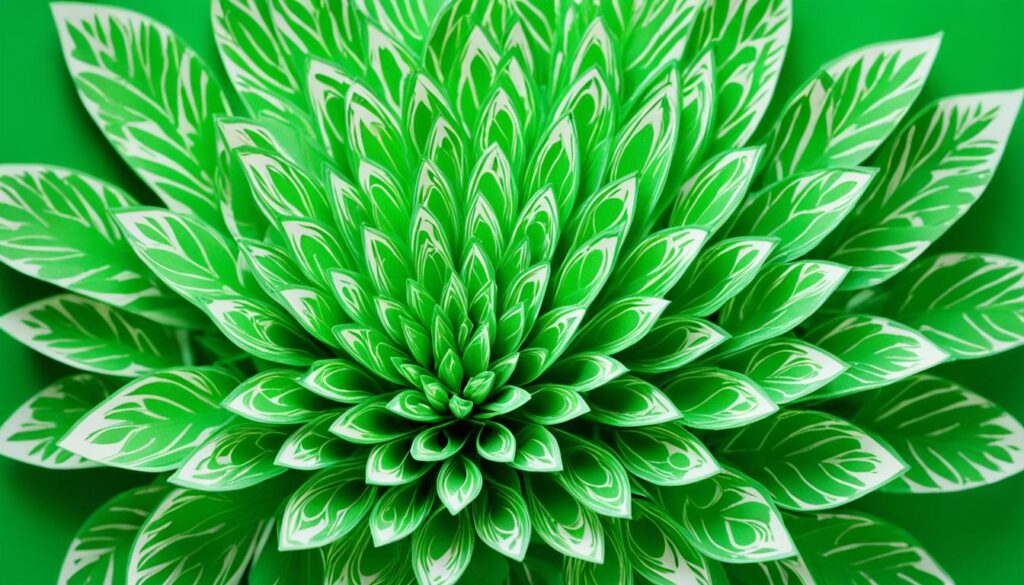
Now we know why the Paper Plant is great for apartments. Next, let’s learn how to grow a Paper Plant in your home.
How to Grow a Paper Plant – Learn to Grow this Indoor Beauty
Growing a Paper Plant indoors needs some special care. I will guide you on how to do it. You need to pay attention to things like the pot and soil. Also, make sure it gets the right light and water. Don’t forget about humidity, food, and cleaning. You also need to handle bugs and diseases.
Choosing the Right Pot and Soil
Choose a pot for your Paper Plant that has holes at the bottom. This stops water from collecting. It keeps the roots from rotting. Make sure the pot is big enough for the plant to grow.
The soil should drain water well. Use a mix of peat moss, perlite, and sand. This helps the plant’s roots stay moist but not too wet.
Providing Adequate Light
Put your Paper Plant where it will get bright, but not direct, sunlight. Near a window is perfect. This helps avoid leaf burn. If there’s not enough sun, use a plant light.
Watering and Humidity
Water the plant when the top inch of soil is dry. Make sure all the extra water drains away. Don’t water too much. This can hurt the roots. Keep the air around it moist. Do this by spraying the leaves or using a water tray with pebbles.
Nutrition and Fertilization
Feed your Paper Plant with liquid plant food when it’s growing. Use half the amount of food the instructions say. Do this every two weeks. In winter, feed it once a month.
Pruning and Maintenance
Trim off any leaves that look dead or yellow. This helps new ones grow. Clean the leaves with a wet cloth. It helps the plant make its food from light.
Propagation
You can make new Paper Plants from stem cuttings. Cut a piece that has leaves and looks healthy. Dip the cut end in hormone powder. Then plant it in damp soil. Keep it in a warm, moist place until it grows roots.
Monitoring for Pests and Diseases
Look for bugs like spider mites and aphids. Catching them early stops big problems. If you find bugs, use natural bug spray or soap and water to get rid of them.
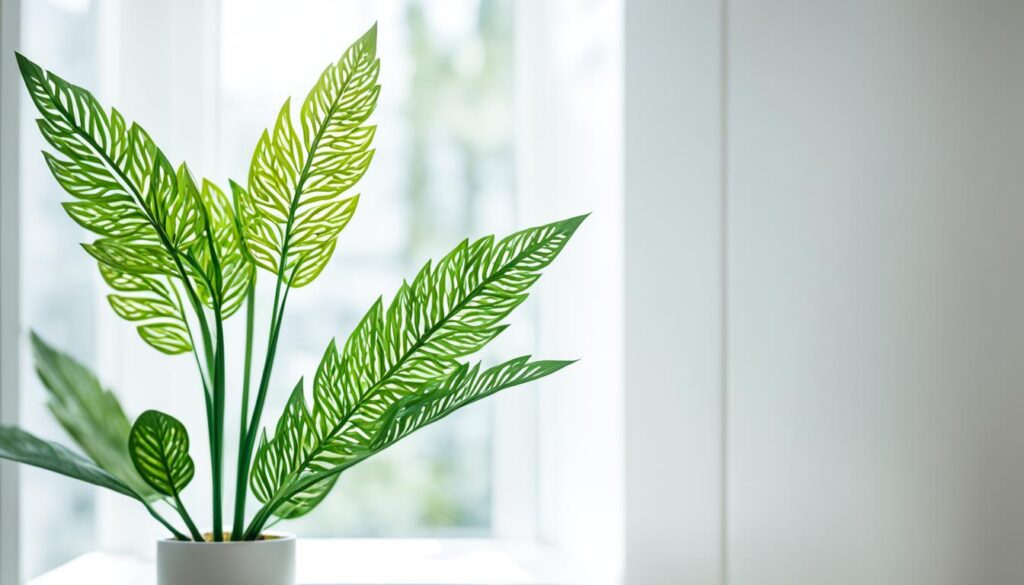
Follow these steps, and your Paper Plant will be beautiful and healthy. With the right care, it will brighten up your home.
| Care Aspect | Instructions |
|---|---|
| Choosing the Right Pot and Soil | Use a pot with drainage holes and a well-draining potting mix. |
| Providing Adequate Light | Place the plant in bright, indirect light near a window. |
| Watering and Humidity | Water when the top inch of soil is dry and maintain humidity through misting or using a tray with water and pebbles. |
| Nutrition and Fertilization | Feed with a balanced liquid fertilizer diluted to half strength every two weeks during the growing season. |
| Pruning and Maintenance | Regularly prune to remove dead or yellowing leaves and wipe the leaves to keep them clean. |
| Propagation | Propagate through stem cuttings dipped in rooting hormone and planted in moist potting mix. |
| Monitoring for Pests and Diseases | Inspect regularly for pests and treat with organic insecticides or soap and water solution. |
Appearance of Paper Plant
The Paper Plant is a pretty sight for any indoor area. It looks unique. Its leaves are big, flat, and look like paper, which is cool. That’s why it’s called the Paper Plant. The leaves feel smooth and papery when you touch them.
This plant’s leaves are a bright, beautiful green. This color makes any room feel fresh and alive. It brings a splash of natural beauty indoors, making spaces welcoming.
Put it on a table or a shelf, and the Paper Plant shines. Its lovely leaves and vibrant color catch your eye. It adds style and charm to any room. People who love plants and decorate homes really like it.
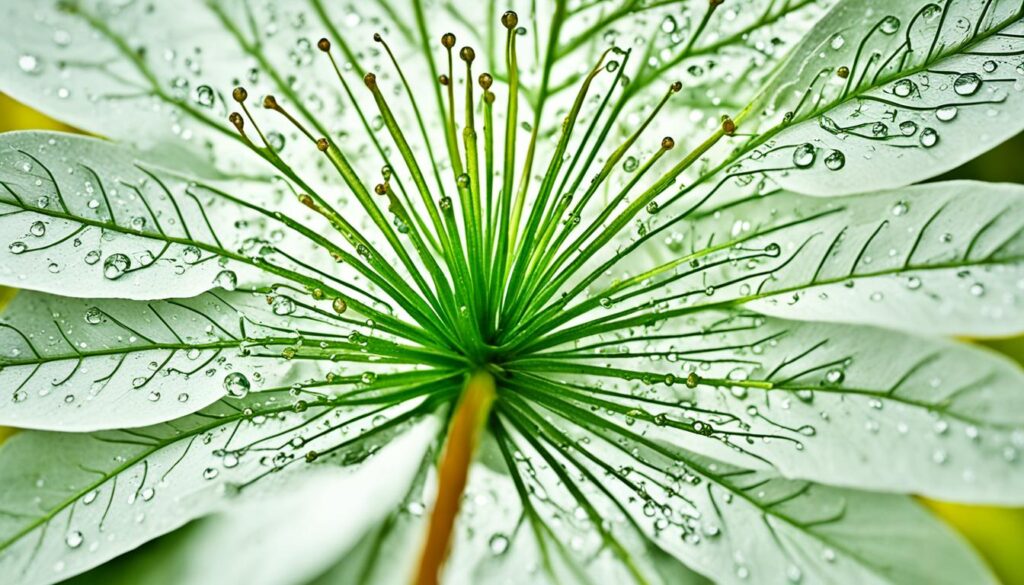
Light Requirements for Paper Plant
The Paper Plant needs bright, but not direct, light to grow well. It can grow in less light too, but it does best with the right light amount. This part will explain how to give your Paper Plant the light it needs.
The Paper Plant shouldn’t get direct sunlight. Too much sun can harm its leaves. It’s best to put the plant where it gets bright, but gentle, light.
Indirect light means the sun’s rays don’t hit the plant directly. You can put the plant near a window that faces north. Or use thin curtains to soften the light. This keeps the plant happy and safe from too much sun.
If the plant is in low light, it will grow slowly. Its leaves might get bigger and darker. This means it needs more light. For the best growth, give your Paper Plant bright, filtered light.
“The Paper Plant thrives in bright, indirect light.”
To check your apartment’s light, watch how bright and long the sun shines in. You can also use a light meter. Aim for 1000 to 2000 foot-candles of light for your plant. This is just the right amount.
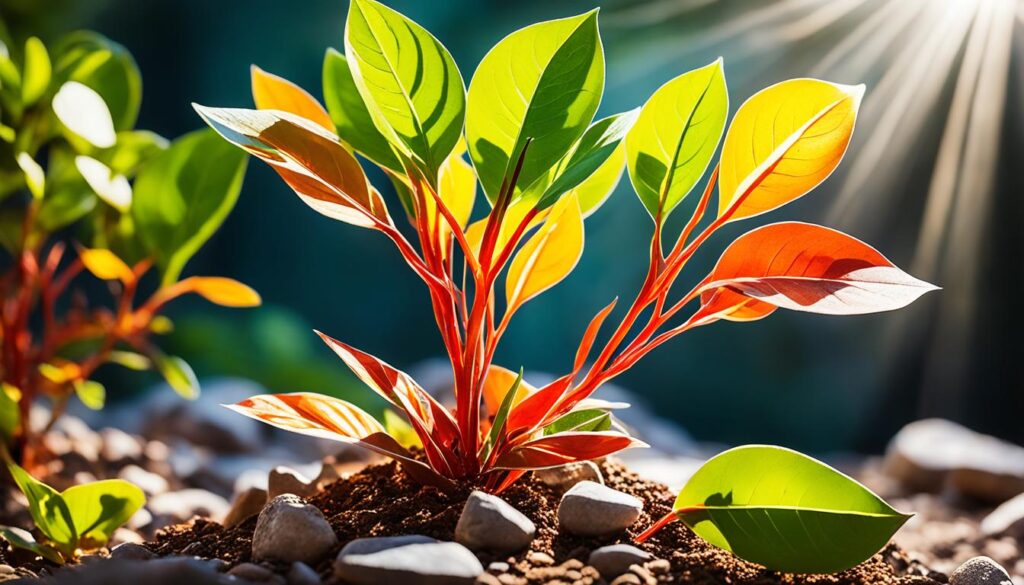
You can use indoor lights to help your plant too. Try fluorescent or LED lights. Hang the lights right above the plant. But don’t put them too close!
Turn the Paper Plant around now and then. This helps it get light on every side. It keeps the plant growing straight and beautiful.
Knowing what light your Paper Plant needs lets you care for it better. With the right light, you can enjoy this beautiful indoor plant in your home.
Watering Requirements of the Paper Plant
It’s very important to water your Paper Plant the right way. This helps it grow well and stay healthy. To do this, you need to know how much water your plant needs. The right amount of water prevents too much or too little water. Both are bad for the plant’s growth and health.
Signs of Overwatering vs. Underwatering
It’s good to know the signs of too much or too little water. Here’s what to look for:
- Overwatering: Signs include wilting leaves, leaves turning yellow, and many leaves falling off. Also, if the soil is always wet or soggy, you’re watering too much.
- Underwatering: Signs are dry, crispy leaves, or leaves turning brown. The soil will look dry. The plant might look thirsty in general.
Plants and places are different, so watch your Paper Plant closely. Then, do what needs to be done.
Give your Paper Plant the right amount of water. Think about what the plant and soil need. Your goal is to keep the soil moist but not too wet or too dry.
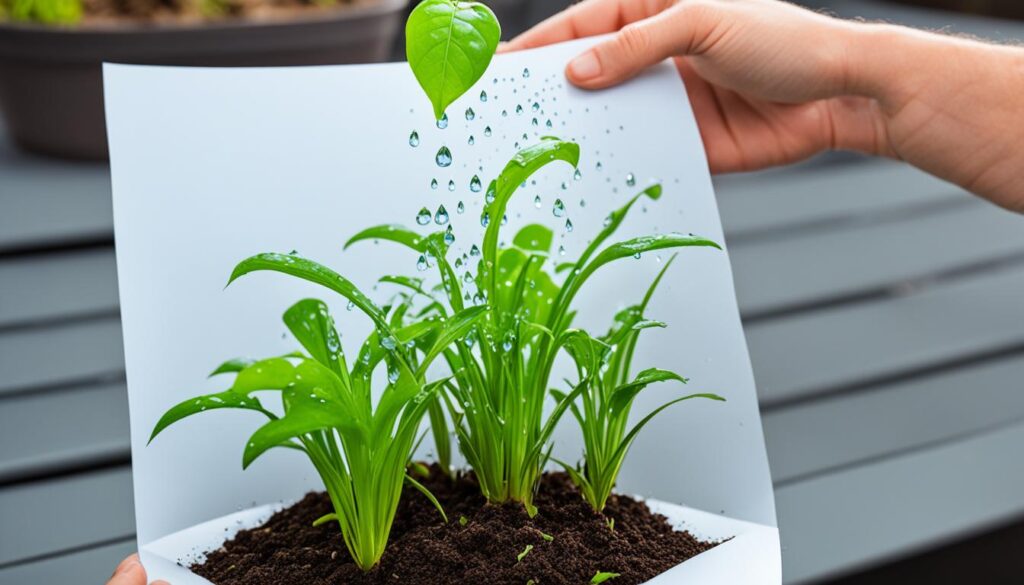
| Moisture Level | Soil Appearance | Watering Frequency |
|---|---|---|
| Optimal Moisture | Slightly damp | Water when the top inch of soil is dry |
| Overwatered | Waterlogged or sodden soil | Reduce watering frequency and ensure proper drainage |
| Underwatered | Dry, parched soil | Increase watering frequency; soil should be moist but not saturated |
Always check the soil’s moisture before watering. You can do this by putting your finger about an inch into the soil. If it feels dry, it’s time to water. If it’s moist, wait until it dries out more.
By watching the soil’s moisture and changing how you water, your Paper Plant will stay healthy and happy.
Fertilizing a Paper Plant
Fertilizing helps your Paper Plant grow well. It gives the plant important nutrients for its health. Let’s talk about how to feed your Paper Plant right. We’ll find the best fertilizer and make a feed schedule.
Recommended Fertilizer for a Paper Plant
Getting the right fertilizer is key for your Paper Plant. Use a balanced fertilizer with a 10:10:10 or 20:20:20 mix. This mix has everything your plant needs to be healthy. You can also use an organic one made for houseplants.
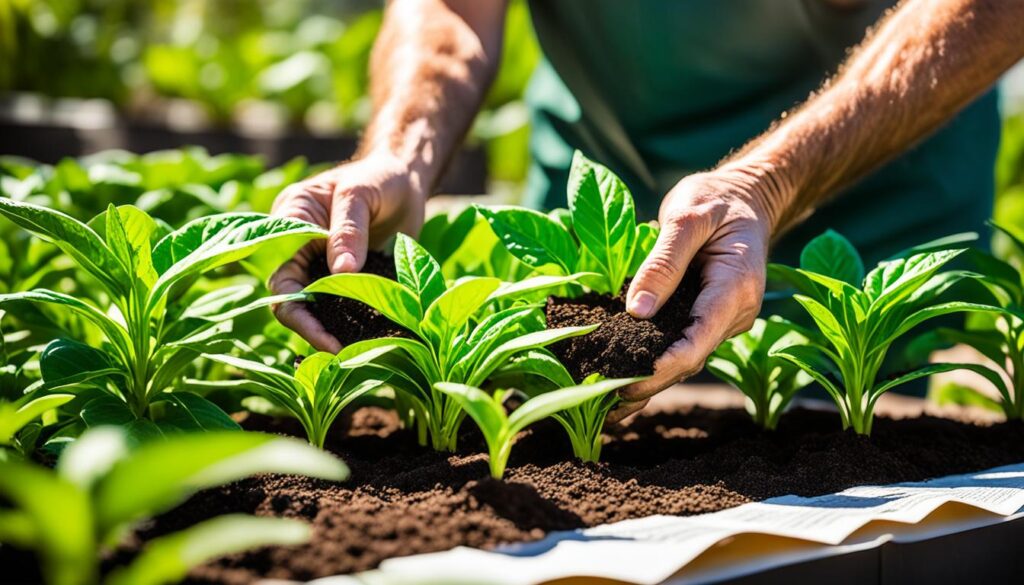
Always follow the package directions for how much and how often to use it. Too much fertilizer can hurt your plant. Mix the fertilizer with water first. Feed your Paper Plant in spring, summer, and fall. This is when it grows the most.
Creating a Fertilizing Schedule
Feeding your plant regularly keeps it healthy. How often depends on the fertilizer and your plant’s needs. Generally, feed every four to six weeks in the growing season. Change how often based on how your plant does.
Water your plant before feeding it. Put the mixed fertilizer in the soil at the plant’s base. Keep it off the leaves to avoid burns.
Feed your Paper Plant as planned for strong growth and green leaves. Watch how it does and adjust the feeding if needed. This keeps your plant happy.
Potting a Paper Plant
Potting helps your Paper Plant grow well. It gives roots room and nutrients. I’ll show you how to pot it right. We’ll look at pot sizes, the best soil, and when to repot.
Choosing the Right Pot Size
It’s key to pick the right pot. Think about how big your plant will get. Too small can hurt its roots. Too big can lead to too much water.
Pick a pot that’s 1-2 inches wider than the last one. Make sure it looks good where you’ll put it. A nice-looking pot makes your room look better.
Using the Right Potting Mix for a Paper Plant
A good soil mix is important. It should hold water but not get too wet. Use a special mix made for indoor plants. It has stuff like peat moss and perlite.
Adding things like compost makes the soil even better. But don’t use outside soil. It’s too heavy and not good for pots.
Repotting When Necessary
If your plant gets too big, it’s time for a new pot. You can tell if roots poke out or if the plant stops growing. Or if the pot tips over easily.
Be careful with the roots when you move the plant. Trim any bad roots. Put the plant in a new pot nicely. Fill in with new soil. Pat it down gently.
After, keep a close eye on your plant. Make sure it’s happy in its new home. Give it the right amount of water.
Propagating a Paper Plant
Making new Paper Plants is a great way to grow your collection. You can use stem cuttings or seeds. This section will guide you on how to use each method.
Stem Cuttings Or Seeds?
If you use stem cuttings, you’ll get plants just like the original. It’s easy and you can make lots of new plants. If you use seeds, the new plants may look different. This can lead to fun surprises as they grow.
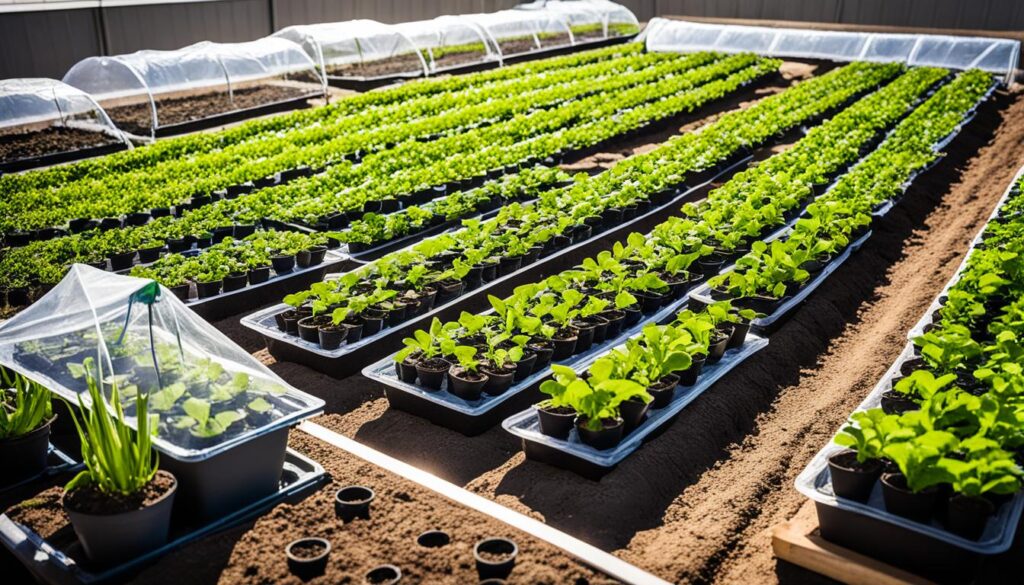
Division Of A Paper Plant
You can also split a Paper Plant to make new ones. This means cutting the plant’s root ball into pieces. Each piece will grow into a new plant.
To split a plant, first take it out of the ground. Clean the dirt off the roots. Cut the root ball into smaller pieces. Each piece needs roots and shoots. Plant them in new pots. Then take care of them and watch them grow.
Whatever way you choose to make new plants, it feels great. It’s a fun way to add to your garden. And you can share your plants with friends.
Growth and Development of the Paper Plant
The Paper Plant, also known as Ficus elastica, is interesting to watch as it grows. It matures into a beautiful indoor plant. It’s important to know its growth stages and size. This helps in providing the right care and enjoying its beauty.
A young Paper Plant starts off small. With proper care, it grows into a lush plant. It makes your indoor space elegant.
In the beginning, the Paper Plant grows fast. Its roots get strong, helping it drink water and get food. Its leaves get bigger and feel like paper.
A big Paper Plant can be 6 to 10 feet tall indoors. The size depends on space, care, and its type. It fits well in homes and small spaces.
The plant grows fast at first. Then, it may slow down but can still look beautiful with care. Light, warmth, and good care help it grow well.
To see how a Paper Plant grows, look at the table below:
| Stage | Size | Timeline |
|---|---|---|
| Young sapling | Small size | 0-6 months |
| Established plant | Medium size | 6 months – 2 years |
| Fully mature | 6-10 feet (1.8-3 meters) | 2+ years |
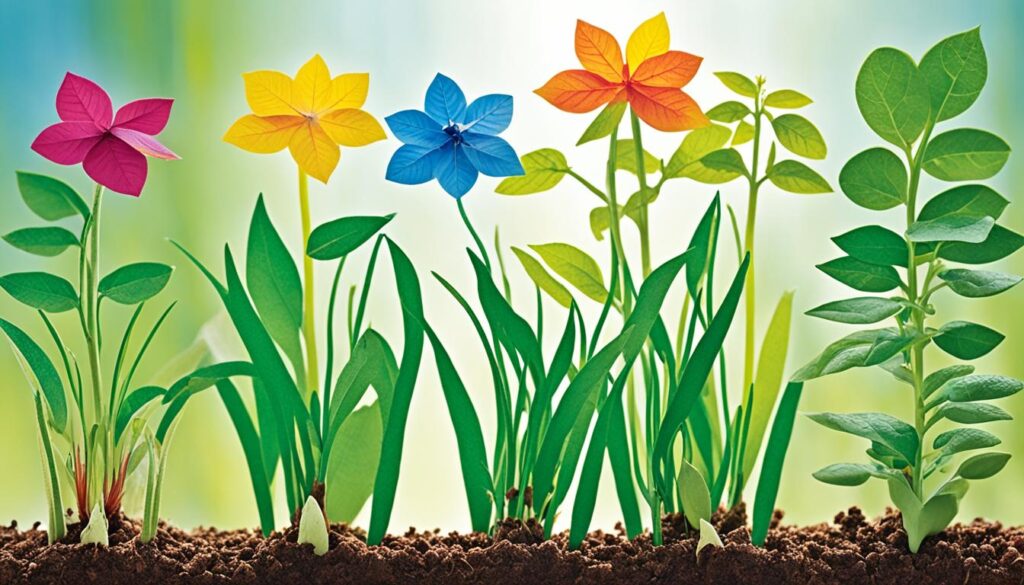
Watching your Paper Plant grow is fun. Seeing it change into a big beauty is rewarding. Don’t forget to give it enough light, water, and food. This helps it grow well and stay beautiful.
Dealing with Pests and Diseases in the Paper Plant
Like other plants, the Paper Plant can get sick or infested. It’s important to know the problems it might face. Also, knowing how to stop and fight these issues is key.
Pests:
Some pests that love the Paper Plant are:
- Aphids: These bugs suck the plant’s sap. This makes it grow poorly and leaves look weird.
- Mealybugs: They are white and fluffy. They also suck the sap and make the plant weak and leaves change color.
- Spider Mites: These tiny pests make webs and damage the plant. Leaves turn yellow and brown.
Diseases:
The Paper Plant can get these diseases:
- Leaf Spot: This makes dark spots on leaves. Leaves then change color and might fall off.
- Powdery Mildew: This looks like white powder on leaves, stems, and flowers. It makes the plant unhealthy.
- Root Rot: This is a fungus on roots. The plant wilts and leaves turn yellow.
Prevention and control:
Keeping your Paper Plant healthy is very important. Here’s how you can stop and handle pests and diseases:
- Always check your plant for signs of trouble. Look for wilting, color changes, or spots.
- If a plant is sick, keep it away from healthy ones. This stops pests and diseases from spreading.
- Keep the area around your plant clean. Remove any dead leaves or trash.
- Good air flow keeps fungus away from your plant.
- To fight pests, use safe things like neem oil or insect soap.
- Sometimes, you might need a plant doctor or special treatments for big problems.
If you watch carefully and act fast, you can keep your Paper Plant safe from pests and diseases. This keeps it happy and healthy.
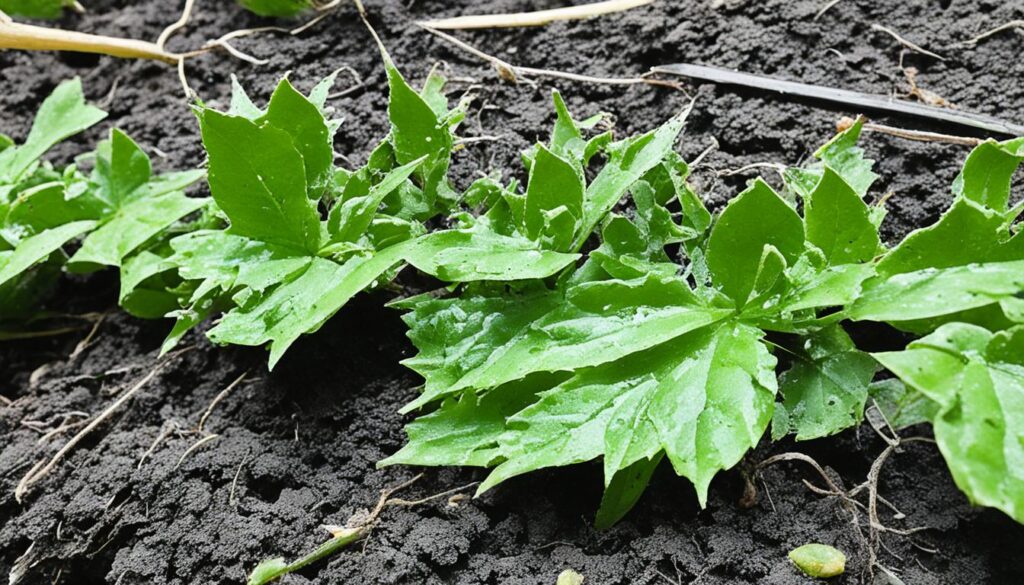
Common Paper Plant Pests
Insects can harm your Paper Plant’s health. Knowing them helps you stop infestations.
Many pests might bother your Paper Plant:
- Aphids: These bugs are small and come in colors like green, black, or brown. They suck the plant’s sap, making leaves curl and turn yellow.
- Spider Mites: They’re tiny and hard to see. They spin fine webs under leaves and drink the sap. This hurts the plant, making leaves discolor and wilt.
- Mealybugs: Mealybugs look white and cottony. They gather on stems and leaves. By sucking sap, they stunt the plant’s growth and make it look weak.
- Scale Insects: These pests are small and oval. They stick to the plant and cover themselves. They eat plant sap, causing yellowing and wilting.
- Thrips: Thrips are skinny insects with wings that have fringes. They eat plant tissues. This causes silver streaks on leaves and messes up the plant’s growth.
To deal with these pests, try these steps:
- Isolation: See pests? Keep the sick plant away from others to stop spreading.
- Natural Predators: Use good bugs like ladybugs to eat the bad ones.
- Manual Removal: For a few pests, pick them off or clean with water.
- Chemical Treatment: Still got pests? Try safe bug soap but follow directions well.
Watch your Paper Plant for pests. Act fast to stop them. Keep your plant clean and healthy to fight off pests. This makes your plant live longer.
| Pest | Identification | Control |
|---|---|---|
| Aphids | Small, pear-shaped insects. Green, black, or brown. Leaves curl and yellow. | Remove by hand or use insecticidal soap. |
| Spider Mites | Tiny, create fine webs on leaves. Discoloration and wilting. | Apply miticide or rinse with high-pressure water. |
| Mealybugs | White, cottony insects. Cluster on stems and leaves. Stunted growth. | Remove by hand or use insecticidal soap. |
| Scale Insects | Small, oval-shaped. Attach to plant’s surface. Yellowing and wilting. | Scrape off with a cotton swab or use horticultural oil. |
| Thrips | Slender with fringed wings. Silver streaks on leaves. Distorted growth. | Apply insecticidal soap or use biological control methods. |
Natural Predators
You have a few ways to fight bugs in your Paper Plant. Using natural predators can help keep things balanced.
Isolate Infected Plants
See bugs or yellow leaves on your Paper Plant? Isolate that plant quick. This stops bugs from moving to other plants. It also helps you treat the sick plant better.
Chemical Treatment
Sometimes, the bug problem is too big. Then, chemicals might be needed. But be careful. Make sure your Paper Plant and the area around it are safe. Use chemicals only if you must.
Follow these steps in your plant care routine. It keeps your Paper Plant happy and healthy. This way, you fight off any bugs trying to harm it.
Disease Prevention For Paper Plants
Keeping your Paper Plant healthy is very important. To do this, you must stop diseases before they start. You can cut down disease risks by taking good care of your plant.
- Plant Hygiene: Clean your Paper Plant’s leaves often. This gets rid of dust and germs. Use something soft and wet to wipe the leaves. Be gentle. This makes your plant look nice and keeps bugs away.
- Sanitation Practices: Keeping things clean stops diseases. Make sure your gardening tools are always clean and germ-free. This stops sick plants from making healthy ones sick.
- Avoid Overcrowding: Don’t let your plants be too close to each other. They need space for air to move around. This lowers humidity and stops diseases from spreading.
- Monitor Plant Health: Always check your Paper Plant for signs it’s sick. Look for changes in color, droopy leaves, or strange growths. Finding problems early means you can fix them fast. This stops the sickness from spreading.
- Quarantine New Additions: When you get new plants, keep them alone for a while. This helps you watch them for any diseases. Doing this keeps your other plants safe.
By keeping your plant clean, using clean tools, not crowding plants, checking plant health, and isolating new plants, you lower disease risks. These steps help keep your Paper Plant healthy and beautiful.
Tips for Maintaining Paper Plants
Keeping your Paper Plant healthy is key. Follow simple steps to make it look great.
Wiping Leaves
It’s important to clean the leaves. Dust blocks sunlight from feeding the plant. Use a wet cloth to wipe each leaf. This helps your plant stay healthy and bright.
Outdoor Exposure
Sometimes, take your plant outside. Put it in a shady spot for a bit each day. This makes it strong and helps it grow. But, watch out for bad weather and bring it inside if needed.
Adjusting Watering Schedule
How much water your plant needs changes. It depends on the air and season. Check the soil before watering. If dry, water it. If wet, wait. This keeps your plant at its best.
These tips keep your Paper Plant looking good. It will be healthy and make you happy.
Tips for Successful Overwintering of Paper Plant
Overwintering the Paper Plant is essential for survival in the cold. Follow these tips to make your Paper Plant thrive in winter.
1. Temperature Considerations: The Paper Plant likes temperatures between 60-75°F. Keep it away from cold drafts and extreme temperatures to avoid damage.
2. Humidity Control: Proper humidity is key. Indoor air gets drier in winter due to heating. Mist the leaves or use a humidifier to increase humidity.
3. Provide Adequate Light: The Paper Plant likes bright, indirect light but can handle less light in winter. Keep it near a window with filtered sunlight. Use artificial lights if needed.
4. Reduce Watering Frequency: Water less in winter as the plant’s growth slows. Let the top inch of soil dry out first. Check soil moisture with your finger.
5. Avoid Fertilizing: Don’t fertilize in winter as the plant is dormant. Wait until spring to fertilize again. Too much fertilizer can hurt the plant.
6. Protect from Cold Drafts: Keep the plant away from places where cold drafts can hit it. Use curtains or plant covers for extra warmth.
7. Monitor for Pests and Diseases: Keep an eye out for pests or diseases. Act quickly to control them and keep your plant safe.
Follow these tips for a healthy Paper Plant in winter. With the right care, enjoy its beauty all year.
Growing Paper Plant from Seed
Growing a Paper Plant from seeds is rewarding. You get to see it grow from start to finish. This guide will help you from germination to caring for young plants.
Germination: Start by soaking the seeds for 24 hours. This softens the seed coat for better growth. After, dry them gently.
Planting: Use a seed tray or pots with good soil. Make a small hole for each seed. Then, cover them lightly and spray with water.
Care for Seedlings: Keep the tray in a warm, light spot. Soil should stay moist but not too wet. Seeds will sprout in 1-3 weeks.
Light and Temperature: Seedlings need bright light but not direct sun. Keep them at 65-75°F during the day. Nights can be cooler.
Transplanting: Ready to move when they have 2-3 real leaves. Be gentle with roots when moving them to new pots. Water them well.
Care: They still need indirect light and moist soil. Don’t overwater. Use diluted fertilizer every 4-6 weeks for extra nutrients.
Your Paper Plant seedlings will grow into strong plants with care. Enjoy watching them develop!
Varieties of Paper Plant
The Paper Plant comes in many kinds. Each one is special in its own way. You can find the perfect one for your tastes and home.
The Philodendron bipinnatifidum, or “Cut-Leaf Philodendron,” is very popular. It has big, palm-shaped leaves. It looks tropical and makes any room more elegant.
Another one to look at is the Philodendron selloum, or “Hope Philodendron.” Its big, shiny leaves stand out. The Hope Philodendron is perfect for making a bold statement.
For smaller places, the Philodendron micans is ideal. This one is called the “Velvet-Leaf Philodendron.” It has soft, colorful leaves. This plant brings beauty and texture to any small space.

